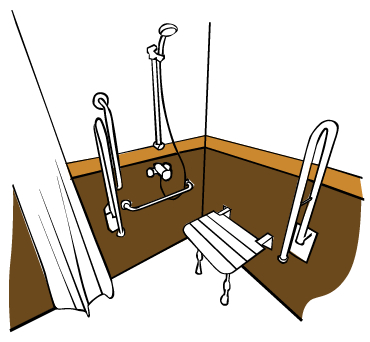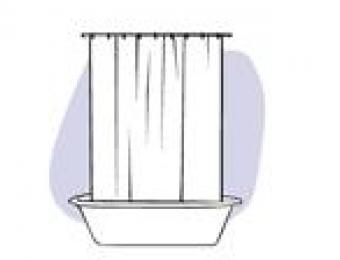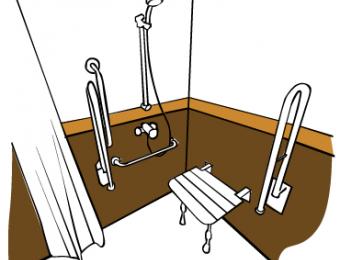Showers are often better than baths for people with physical disabilities, simply because they're easier to get in and out of. A shower requires much less assistance to operate, and fewer modifications to make safe for those with disabilities. This allows people far more independence and freedom. Wet rooms in particular are ideal showers for those with mobility impairments, because they aren't restrictive like shower stalls, and normally don't involve a step.

Shower seats
One common enhancement for those with disabilities is a seat in the shower. These are often wall mounted, and designed to fold away when not in use, although they can also simply be free-standing chairs with rubber feet that you place in the shower stall. They come in a range of materials and colours ranging from PVC to aluminium, some sporting vinyl padded cushioning. The size and weight capacity of the seat need to be considered when purchasing, as will final positioning in the shower. Make sure to leave enough room not only for the seat, but for someone to sit on it comfortably and still benefit from the water’s flow.
Easy to use taps
The type of tap you choose may have a significant bearing on how useful the shower is, especially if the person using it has arthritis or a similar ailment that limits their ability to use their fingers, thumbs or wrists. A single handle mixer tap incorporates a single paddle which can be lifted to control flow and twisted to control temperature. This type of tap can easily be controlled using just about any appendage, and is unlikely to ever be closed tightly enough to be challenging to the user.
Grab rails
Grab rails (or grab bars) can also be installed at strategic locations to help people manoeuvre. Grab rails come in a range of diameters to provide for different uses and purposes, with 32mm the most commonly used diameter. Grab rails for showers should typically be purpose-built for that use, to ensure that they aren't prone to rust. It's also a good idea to look for a rail with a non-slip finish for added grip.
A horizontal grab rail is normally installed underneath the shower controls, often attached to a vertical grab rail which travels up the wall at one end of the horizontal rail to form an 'L'. Many manufacturers also create adjustable handshower heads attached to this vertical part of the rail, which allow the height of the shower to be adjusted as necessary. In some situations an approach rail may also be a good idea, to help people getting in and out of the shower area. Grab rails come in standard lengths (300mm, 450mm, 600mm and 900mm), although they can also be custom built to suit the position of wall studs.
Folding doors and stepless bases
A folding door and stepless base can make getting in and out of the shower much easier for wheelchair access, and for people who can't easily raise their legs. Folding doors opens in a concertina fashion, which allows for a much wider opening without needing as much room. Having a stepless base means it is perfectly flush with the floor, so it doesn’t require any lifting at all to enter. This base can be adapted to suit your current flooring, even if it’s adjoining wooden floor boards.
Installation and manufacturing standards
All disability enhancements should be tested very thoroughly for any weakness as a part of the installation. It's far better to find out during installation than have them cause accidents when used. While it's not legally required that grab rails and other disability enhancements adhere to Australian Standards in domestic dwellings, these Standards do set the benchmark and are considered to be the 'best practice'. The particular Standard suite in question is AS1428 - Design for Access and Mobility.
Your installer should be a qualified professional, and where fixtures are bolted to the wall, the composition of the wall should be taken into account. Permanent rails and seats should ideally be affixed to a wall stud for maximum strength.


